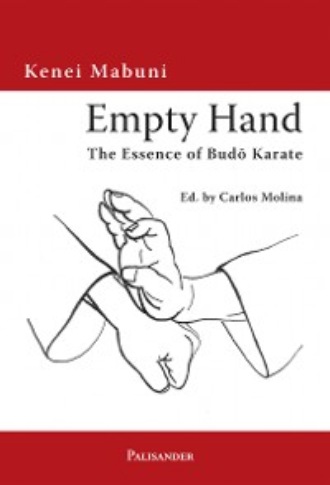
Полная версия
Empty Hand

Empty Hand
Kenei Mabuni
In cooperation with Masahiko Yokoyama
Empty Hand
The Essence of Budō-Karate
Edited by Carlos Molina
Translated from Japanese
by B. Winter
Palisander
As to the notation of the Japanese personal names: On the cover and the title sheet the name of the author has been written according to the conventions of the English-speaking countries, i.e. in the order first name, last name. In the text of the book the usual notation of Japanese names is used, i.e. the last name followed by the first name.
The publisher would like to thank Jörg Seidel, Chemnitz, for proofreading the English edition. Furthermore he thanks Patrick McCarthy, Brisbane (Australia) for putting the photograph of Itosu Ankō at his disposal.
First English Edition
1 st ed. May 2009
Original title:
武道空手への招待(»Invitation to Budō-Karate«)
© 2001 by Sanko-sha Ltd.
Translation from Japanese by B. Winter
© 2009 by Palisander Verlag, Chemnitz
All rights reserved. No part of this book may be reproduced in any form by any electronic or mechanical means (including photocopying, recording, or information storage and retrieval) without permission in writing from the publisher.
Cover design: Anja Elstner, using a drawing by Matthias Stein and the Shitō ryū emblem.
Publisher's editor: Frank Elstner
Setting: Frank Elstner
1 st Digital Editon
Digital Publication by Zeilenwert GmbH
ISBN 9783938305249
www.palisander-verlag.de
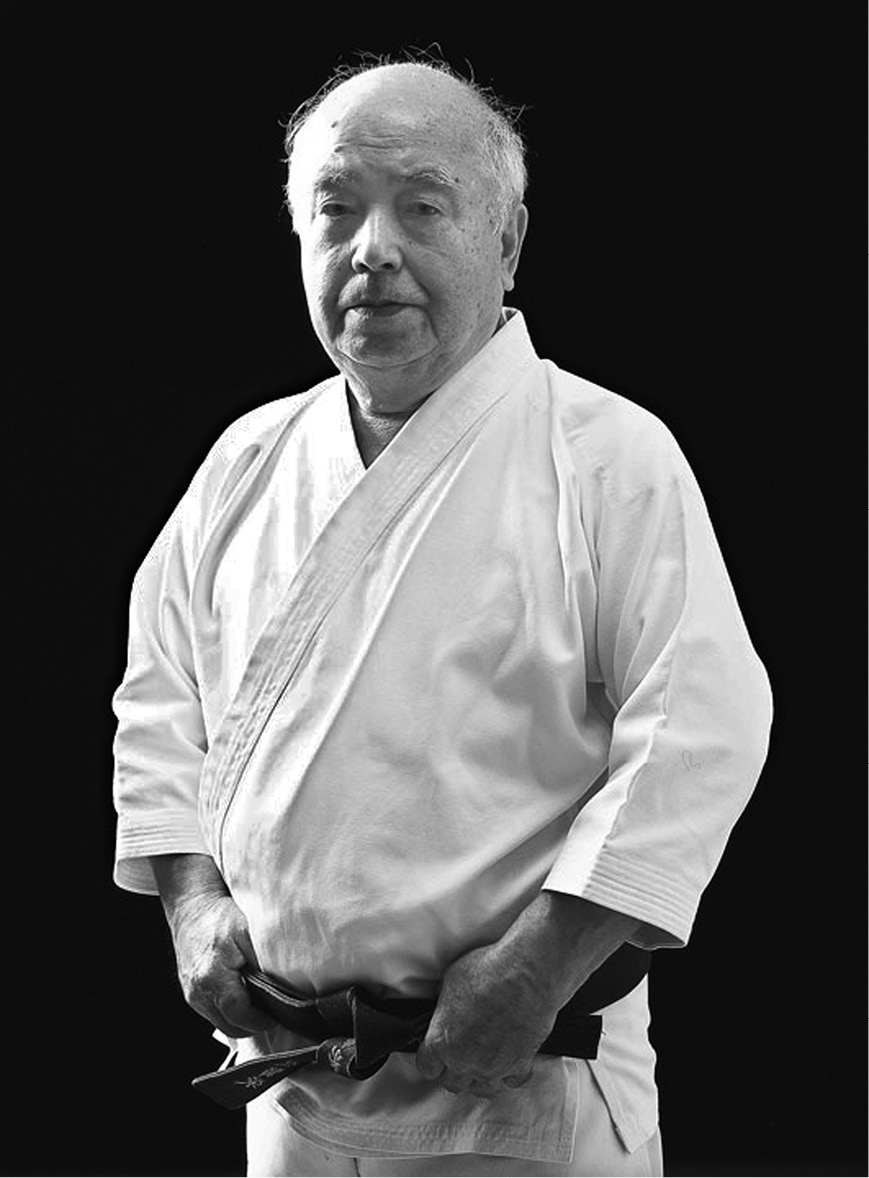
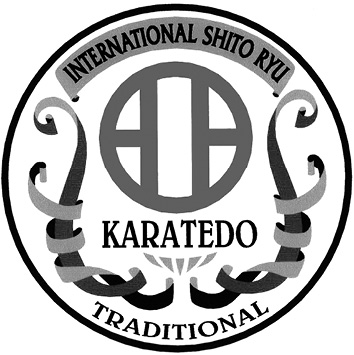
Union Shitō ryū Europe
Internet: www.shitoryu-europe.org
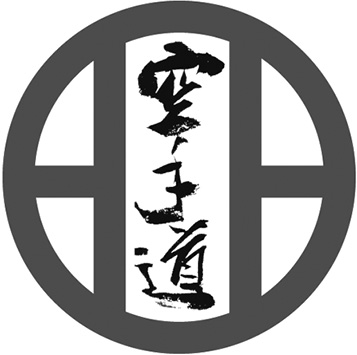
The Author
Mabuni Kenei, holder of the 10th Dan, was born in 1918 on Okinawa, the birthplace of karatedō. As the son of Mabuni Kenwa, the founder of the Shitō ryū and one of the most important karate experts in history, from his childhood on he was in touch with karate and some of its greatest masters. At the age of 34 he became the head of Shitō ryū. Even today, in his old age, he holds seminars in different parts of the world where he teaches authentic karatedō.
The Publisher
Carlos Molina, the editor, holder of the 7th Dan, was born in 1947 in Quetzaltenango, Guatemala. He became one of the first disciples of Mabuni Kenei in Latin America. Since 1976 he has introduced the Shitō karate in the Federal Republic of Germany. Today he is the Shitō ryū representative in Germany.
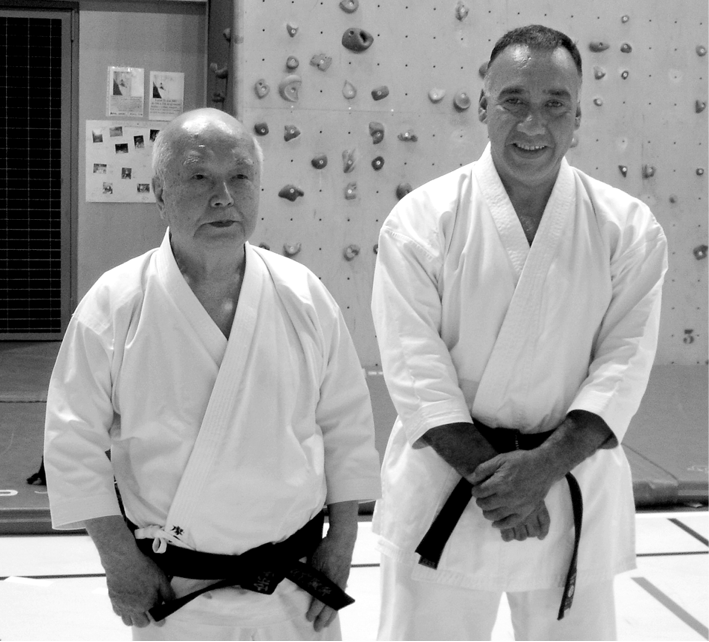
Acknowledgement
The editor thanks his disciple Mrs Silvia Pellegrini for her extraordinary efforts to realize this project.
Illustrations
The copyright for the photograph on p. 4 and for the photographs no. 5 to 10, 12 to 15, 20, 22, 24 to 80, 82 to 87 and 96 is owned by the author. The copyright for the photograph on p. 6 and photograph no. 21 is owned by Carlos Molina. The other photographs and illustrations are public domain. On many of the photos Mizuguchi Hirofumi – sometimes together with the author – can be seen demonstrating techniques.
Table of Contents
Cover
Titelpage
Copyright
Sōke Mabuni Kenei
Author
Preface by the Editor
Introduction
A Martial for Everyone
Karate as a Means for Physical, Martial and Spiritual Education
The Emergence of Modern Karate
Karate and Health
The Physical Effects of Karate
Karate in Dangerous Situations
Karate as a Spiritual Martial Art
The Breathing Techniques in Karate
The State of Total Inner Calmness
I Budō Karate
1 The Development of Karate
1.1 Karate as Fighting Technique
Unarmed Fighting in Ancient Times
Shaolin Kempō – the Fighting Techniques of the Warrior Monks
The Influence of the Chinese Kempō on the Japanese and Okinawan Martial Arts
Karate – the Fundament of Martial Arts
1.2 The Emergence of Karate on Okinawa
The Old Okinawa-te
The Kata of the Shuri-te
The Jigen Sword Technique and the Shuri-te
Drawing a Circle With a Straight Line
The Emergence of the Naha-te
The Origins of the Tomari-te
The Shitō Style as Heritage of the Okinawa-te
2 Shitō Karate – the Teachings of Mabuni Kenwa
2.1 “Captured” in the World of Budō
Striving for a Healthy Body
A Life Without Selfishness and Greed
Praised by Kanō Jigorō
Funakoshi Gichin Learned Kata From My Father
The Creation of the Shitō Ryū
Following My Father’s Footsteps
My Father’s Goals
Shitō Karate is Authentic Budō Karate
2.2 The Pleasure of Learning and Teaching Karate
How to Teach Karate
Karate for Children and Youngsters
The Wealth of the Traditional Kata
Karate in Europe
A Lack of True Leaders in Karate
3 How to Overcome the Own Limits
3.1 Karate – More than Kicks and Punches
Yagyū Sekishūsai and the Art of Mutō Dori
Karate Turns the Whole Body into a Weapon
How to Harden the Body
Thrusts with Muchimi
Karate as Support for Every Budōka
3.2 Blocking is Attacking – Without Beat
Starting With a Block
Blocking the Opponent’s Attack With a More Powerful Counterattack
Rhythm and Speed
The Five Principles of Blocking
3.3 Learning the Techniques
The Diversity of the Kata Techniques
Three Principles of the Bujutsu
The Principle of Hikite
Understanding the Heian Sandan Kata as Fighting Technique
The Gojūshiho Kata, and how to Cope with Unexpected Attacks
The Kata Niipaipo and Haufā
4 Criticizing Present-Day Budō
4.1 Budō Becoming Sport
Sport or Martial Technique
Competitive Sports and Ritual Games
Hagoita – Ritual and Game
Sports or Budō – What is More Serious?
Separation of Sports and Budō
Sundome and Full Contact
4.2 Modern Competition and Budō
The Assessment of Competition Kata
Is Modern Karate Really a Progress?
Flowing Techniques – Consciousness Going Ahead
Learning in the Flow of the Practice
The Reductionism of Sports
Competition Karate Returning to Ancient Patterns
4.3 The Unity of Soul, Body and Technique
Testing the Abilities Before Kumite Came into Use
Harmony instead of Competition
“There is no First Attack in Karate”
II The Spirit of Budō
1 The Essence of Budō
1.1 The Difference between Budō and Violence
Taking Life, Giving Life
Karate and the Spirit of Respect (Shurei)
The Meaning of the Karate Techniques
The “Superhuman Techniques” of Ueshiba Morihei
The Main Principle of Karate: The Body Follows the Mind
1.2 Beyond the Natural Movements of the Body
Reacting to Natural Changes
“God-like” Techniques, and the Falling Dewdrop
The Magic Experience of the Control of Gravity
Ambling, and the Parallel Punch
The Release of Power in Budō and Sports
The Crab Walk, and “Taking the Knees out”
2 Victory or Defeat
2.1 Their Famous Fights
Ōyama Masutatsu’s Report
A Lack of Heroic Stories
Matsumura’s Fight with his Bride
Matsumura and the Bull they Called “the Killer”
Knocking down a Raging Bull
2.2 Not to Lose Means Winning
Victory Without Struggle
A Victory by Running Away
Matsumura Sōkon and the Big Guy
The “Miyamoto Musashi of the Ryūkyūs”
2.3 The Absolute Will to Win in the Yagyū Ryū
Sword Fighting and “Mental Cleansing”
The “Life Saving Sword”
Mutō Dori and the Point of Origin of Karate
Yamaoka Tesshū and the Mutō Dori
Karate and the Yagyū Ryū
2.4 The “Soundless Kamae”
The Satori of Yamaoka Tesshū
“There is no Kamae in Karate”
The Simultaneous Withdrawal of Both Opponents
The Utmost Spheres of Bu Are Beyond those of Zen
A Sword with Blunt Blade
3 Karate as “Zen in Motion”
3.1 The Sphere of Emptiness (Kū) in Karate
Karate as the “Fist of the Nobles”
The Sūpārinpai Kata and the Worldly Desires that Cause Suffering
Karate – the Hand Reaching into the Spheres of Emptiness
The Enlightenment of the Novelist
The Buddha Nature in the Depths of the Heart
3.2 “Zen in motion”, and the Rules of Breathing
“Zen in motion” – the Unity of Body, Soul and Technique
Arranging the Soul
Regulating Body and Breathing
Types and Forms of Breathing
Yin and Yang in Breathing
3.3 Preventing Disorder
Methods to Prevent Disorder
The Story of the Marvelous Techniques of the Old Cat
Theory and Experience
The Spirit of Death Defiance
Preventing Disorder
Bu – Never Accomplished
Afterword by the Editor of the Japanese Edition
Footnotes
Preface by the Editor
I met sensei Mabuni Kenei for the first time in November 1965. At that time I was 18 years old and sensei Mabuni came to my hometown Quetzaltenango for a karate demonstration together with a group of karateka from the capital Guatemala City. Already in ancient times Quetzaltenango was a Maya city and it is the second largest city of Guatemala today.
Sensei Mabuni had already been staying in Central America for a year, at first in Mexico following an invitation by sensei Murata Nobuyoshi, and then in Guatemala where at that time about one thousand karateka were practicing Shitō ryū.
I still had no karate experience, nevertheless I realized that there was a great difference between the way of moving demonstrated by sensei Mabuni and the performance of the other karateka representing various schools. I was so impressed that I decided on the spot to study karate. So, I joined the Shitō ryū club in my hometown. My first teachers were Jorge Sosa and Nobuyoshi Murata. I learned the basics of Shitō ryū and a lot about the history of the Mabuni family from sensei Murata.
In 1969 when I received the 1st kyū I got the chance to attend a lesson by sensei Mabuni in Guatemala City. This was a great honor for me. About 20 disciples, all of them holders of the 1st kyū degree participated in this lesson. We all had studied different karate techniques for several years, but Sensei Mabuni exclusively trained breathing techniques with us. After two hours of such exercises, of the 20 participants only a friend of mine and myself were ready to continue. The other ones left the training room because they could not bear the constraints caused by the breathing techniques any longer. When the two of us were alone with sensei Mabuni he said: “Now you can begin to study karatedō.”
Sensei Mabuni stayed for another year in the Guatemalan capital. To attend his lessons we traveled every week the 120 miles between Quetzaltenango and Guatemala City.
In 1974 Sensei Mabuni came for the last time to Guatemala. At that time I held the 2nd dan. In 1976 I decided to visit my Sensei in Japan. However, on the way to Japan first I came to Europe – to Berlin. Here I met a lot of people who asked me to teach them karate. So, I stayed there.
I met Sensei Mabuni again only in 1984 – on Corsica. He was invited by sensei Nakahashi Hidetoshi who had been living in France for many years. Hence I became a disciple of sensei Nakahashi until sensei Mabuni accepted me as his uchi deshi1. Since then I have been trying very hard to deepen my understanding of Shitō ryū karate under the guidance of sensei Mabuni and supported by sensei Nakahashi and Sensei Hatano. Thanks to sensei Mabuni I could learn a lot about the essence of budō karate. He always emphasized that karate is no sport but a way of life that can be helpful in any situation.
I feel grateful and happy that sensei Mabuni has decided to express his ideas in this book that has become not only a source of the Shitō ryū but also shows the history of the origins of karate as martial art and way of life. When I look back to my first steps in karatedō, trying to compare my personal character of those days with the present one I realize how much I have changed. Only now I begin to understand what he ceaselessly has taught since then. Sensei Mabuni always stressed the importance of values like politeness, charity, respect and grace, and he always warned us of the dangers of mistrust, laziness, pride and envy. Although I am not always able to achieve all of this in my own life I begin to understand that these values are the basis of social and human existence. There is a motto he always uses to repeat and that is now deeply ingrained in my heart: “Try to improve, become better today than you were yesterday, and tomorrow become better than today.”
I am deeply grateful that sensei Mabuni gave us this book. It is a treasury of wisdom!
Shihan Carlos Molina, Corsika, 1 August 2007
Introduction
A Martial Art for Everyone
I was born in 1918. I have been happy to spend all my life with karate. My father, Mabuni Kenwa, who founded the Shitō karate, always said: “Anyone can practice karate, young and old people, men and women.” Karate can meet different needs of different people. It can be used to take care of the health and to maintain beauty and fitness, and of course it can be a means of self-defense or of real fighting. But that is not all. In particular budō2 karate is not only a system of physical techniques, called taijutsu, but also rich in mental techniques, called shinjutsu. Once during a kata performance by an experienced karateka, I heard a bystander saying: “Just by feeling this spiritual energy, I understand that karate is something of great value.”
Other people like karate as a means of artistic expression. For example, at the Sydney Olympic Games in 2000 the Austrian team in synchronized swimming caused considerable public discussion because they included a karate kata called Heian yondan into their performance. In August 2001 in the Nihon Budōkan the 3rd Shitō Karate World Meeting took place. I met a famous Japanese dancer there who told me: “I can see a connection between karate and dance.”
To my mind karate can be compared with a huge mountain that can be climbed via many different paths, which will reveal very different sights according to the point of view or to the season. Neither the aims nor the paths of this mountain hiking adventure are fixed. Some walk slowly up the hillside to build up their physical strength, others, the ambitious mountaineers, want to climb the highest and steepest summits at any cost.
Karate as a Means for Physical, Martial and Spiritual Education
Education and development in karate comprise three main elements: the physical, the martial and the psycho-spiritual aspect. As a means of physical education it improves the health and provides the basis for a long and healthy life. It helps to build up fighting abilities, and as a method to strengthen mind and soul it can contribute to reach a high level of vitality and mental energy. These different elements are closely connected and support each other. Which of the aspects is prevailing depends on the practitioner’s motivation and aims.
With regard to the fighting abilities there are some common misunderstandings. Many people are afraid when they hear words like “real fight karate” or “street fighting karate”. “Real fight situations” can be considered as rather rare occasions in the everyday life of average people unless such situations are provoked deliberately or one searches for them. But in the past few years, more and more cases of unprovoked attacks or conflicts escalating into violence in the streets or in public transport facilities have happened to occur even in Japan, which is considered as one of the most secure and most disciplined societies of the world. Especially in times of change, family members or friends might be threatened and forced to fight. So, one should be prepared. The best way to escape such situations is to avoid the attack of an enemy or to hit him at vital points in order to gain time to flee.
Normal people are only confronted with a real fight when they have to defend themselves. For the samurai in times of feudal wars, or for the soldiers in the world wars “real fighting” meant simply to kill each other. At this point I must admit that the masters of karate, like myself, practice day by day a bujutsu3 karate that surpasses the limits of self-defense. And, frankly speaking, techniques that surpass the limits of self-defense are techniques to kill people, called satsuhō. It sounds a little bit daring to say it, but this was the starting point of karate as budō, i.e. as “martial way” or “warrior’s way”. But it should be taken into consideration that by practicing budō karate one is doing the same as members of military units are doing who acquire techniques to kill in order to defend their homeland, the land of their ancestors.
The techniques of “minimal” self-defense that are not designed to kill people were developed from techniques that had the purpose to kill.
The Emergence of Modern Karate
The man who later was called “founder of modern karate” was Itosu Ankō (1830-1916), also named Yasutsune. He was the greatest master of the Shuri-te, which represents the original Okinawan hand-fighting techniques, te.4 Master Itosu reorganized karate when it became part of the official curriculum of middle school education in Meiji-era Japan.
Master Itosu chose traditional techniques and modified them in such a way that they could be used for physical education. According to the ideals of modern physical education, highly dangerous techniques where replaced by techniques that were demanding and rich in substance and at the same time efficient with regard to physical education. So, the Passai dai kata contains a sequence from a side sweep (yoko barai) to a kick (geri), which was originally a movement from a spear hand stab in the eyes (kaishu metsubishi) to a kick to the genitals (kinteki). – Itosu Ankō created for example the group of the five Heian kata which is still very popular. According to the Japanese word Heian, which means calm and peaceful, this kata does not contain attacks on the so-called “golden targets” (e.g. the genitals and other vital points) and no dangerous techniques like the “eye crusher” (metsubishi).
The founder of Kōdōkan Jūdō, Kanō Jigorō (1860-1938), proceeded in the same way when he removed all throwing techniques (nage waza) and blows (atemi) which had the potential to kill from traditional jūjutsu, thus developing modern jūdō. These were results of the modernization process the movement for cultural reform was aiming at.
But in Shitō karate a lot of old kata remained. Although they were reformed by Master Itosu, there are numerous hidden techniques that have been handed down to us as non-written secret knowledge. Amongst them were rather cruel techniques to kill. One of my most diligent students, Terada, led the karate lessons in a club of a school that his son also used to attend. Once he told me laughingly that his son had criticized him saying: “Dad, your karate is always against the rules.” This touches the question whether such dangerous techniques should be part of karate practice and whether a martial education makes sense that surpasses the limits of self-defense. As stated above, attacking in order to defend oneself is part of the essence of karate. Indeed there is a certain “borderland” in the study of karate where one learns how to kill very efficiently. That means entering the world of budō. This problem is in fact the most important topic of this book. But first I would like to write about today’s values and the general aims of karate.
Karate and Health
My father had dedicated his life to the development of karate as a means of physical education already before I was born. In the world of martial arts he was called “Mabuni the technician”. Being one of the inheritors of the authentic Okinawan hand-fighting techniques (te), he was generally considered to be an outstanding expert with respect to techniques. He wanted to develop and spread karate as a method to improve the health situation of the general population.
In contrast to other martial arts, in karate the physical abilities can be enhanced by kata practice. All in all there are about 50 classical kata. Of course not all of them must be learned unless one wants to become a karate teacher. Kata are sequences of movements of attack and defense with respect to one or several imaginary opponents. In order to execute them no training devices are needed. Kata are easy to practice even in larger groups of people, and their practice can be a source of joy. There are some beginners who are afraid of kata exercises with partners called kumite. But in case one practices karate exclusively for one’s health, kumite is not needed. Furthermore one needs only little space. An area of 3.5 to 4 tatami mats (about 75-85 sq ft) should be sufficient.
The Shitō karate developed by my father contains the traditional Okinawan hand-fighting techniques of the Shuri-te and the Naha-te. Apart from some small technical differences, it is a typical feature of the Shuri-te kata that they consist of many effective and fast attack and defense movements designed for long-distance fighting. For the Naha-te kata, close-distance fighting is typical, with “heavy” movements and a special breathing technique derived from Chinese Fukien kempō5. Having such a broad basis it is easy to find the appropriate kata for any age and any kind of physical condition. This is the great advantage of Shitō karate.



